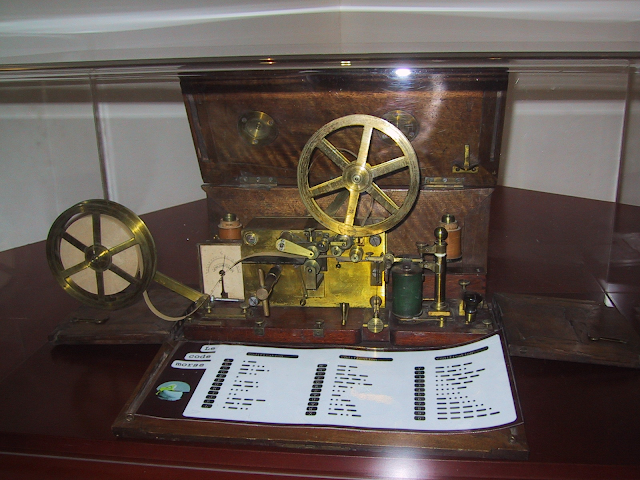© Mark Ollig
In 1832, Samuel Morse considered the making of an electric telegraph while on board a ship returning to New York City from Europe.
Despite lacking formal electrical training, from 1835 to 1836, Morse developed a working telegraph model that transmitted information via electrical pulses over a pair of wires, as using a single wire with an earth-ground return path was yet to be widely understood.
Early telegraphs used two wires to form a circuit: one to carry the electrical signal generated by the telegraph key and the other to provide a return path for the electrical current back to the battery, completing the circuit and allowing the signal to be transmitted.
Morse’s early model telegraphs used galvanic (or voltaic) cell batteries, which Alessandro Volta invented in 1800.
Each cell produced roughly one volt, but multiple cells were connected in series to achieve the higher voltage required for longer transmission distances.
In 1837, he collaborated with Alfred Vail to improve his telegraph for sending and receiving coded messages.
In addition, Vail’s family business, the Speedwell Iron Works in Morristown, NJ, was used to build improved telegraph models.
Morse collaborated with Leonard Gale, a science professor at New York University, whose expertise in electromagnetism helped overcome technical hurdles.
Gale’s suggestion to use an electromagnet at the receiving end significantly improved the telegraph’s ability to transmit signals over long distances.
Morse, Vail, and Gale demonstrated a working electromagnetic telegraph model at the Speedwell Iron Works Jan. 6, 1838, successfully transmitting coded signals over a distance of two miles.
Briefly pressing the steel telegraph key closes an electrical circuit, sending a pulse of current to the receiving telegraph.
A quick tap produces a short pulse (a dot), while a longer press generates a longer pulse (a dash).
These coded signals traveled through the telegraph wire to the receiver, also known as a register, where an electromagnet moved a stylus, marking the dots and dashes as indentations on a moving strip of paper.
This 1838 code, developed primarily by Vail, was a numerical code where each word was assigned a number, and the corresponding number was then transmitted using dots and dashes.
However, Vail would go on to refine this coded version into what became known as Morse code, the universal language of telegraphy.
Morse was granted US Patent No. 1,647 for the telegraph June 20, 1840.
In 1843, he secured $30,000 from the federal government to construct an experimental telegraph line between Washington DC and Baltimore, MD, a distance of nearly 40 miles.
Morse sought to demonstrate the viability of long-distance telegraphic communication.
The construction of the telegraph line began April 1, 1844.
The initial nine miles of wire, buried in lead pipes, quickly proved unsuitable as moisture seeped in, corroding the copper and disrupting the signal.
Underground wires were abandoned for overhead lines attached to some 700 chestnut poles spaced 300 feet apart along the B&O Railroad route.
Each pole supported two 16-gauge copper wires insulated with layers of cotton thread and shellac, with a beeswax and resin mixture in some sections providing additional protection.
Samuel Morse sent the first long-distance telegraph message, “What hath God wrought?” (Numbers 23:23), from the Supreme Court chamber in the US Capitol to Alfred Vail at the newly-established telegraph office within the B&O Railroad’s Mount Clare terminal station in Baltimore May 24, 1844.
Vail interpreted the indentations on the paper strip, translating Morse’s dots and dashes into the words they represented.
The 1844 Washington-Baltimore telegraph line relied on batteries comprised of multiple galvanic cells to power it.
While the specific battery type used in the line remains uncertain, Morse likely employed the Daniell cell (available since 1836) due to its stability and practicality.
Regardless of the specific type, dozens of cells connected in series would have been necessary to achieve the higher voltage required for the nearly 40-mile long-distance.
Early telegraph systems used two wires to complete the electrical circuit, one to carry the signal and another to return the current to the battery.
As the understanding of electrical principles evolved, including the realization that the earth itself could serve as a conductor, single-wire telegraph systems emerged later in the 19th century.
These single-wire systems, using the earth as an electrical return path, reduced the costs of installing and maintaining telegraph lines and expanded long-distance communication.
An improved telegraph with an electromagnet-activated armature “sounder” converted coded signals into audible clicks, enabling faster decoding and message transcription by the operator.
In June 1860, the US Congress passed the Pacific Telegraph Act, authorizing funding for a transcontinental telegraph line.
In August of that year, the Minnesota State Telegraph Co. connected St. Paul to Winona, expanding the telegraph network westward.
In November, the line reached Minneapolis.
The St. Paul Weekly Pioneer and Democrat newspaper published the “Latest News by Telegraph to St. Paul” column Dec. 28, 1860.
The Western Union Telegraph Company completed the transcontinental telegraph line Oct. 24, 1861, connecting the east and west coasts.
Leonard Dunnell Gale (1800 to 1883), Alfred Lewis Vail (1807 to 1859), and Samuel Finley Breese Morse (1791 to 1872) collaborated on the development and successful deployment of the 19th-century telegraph network.


